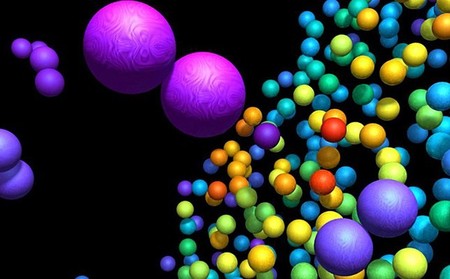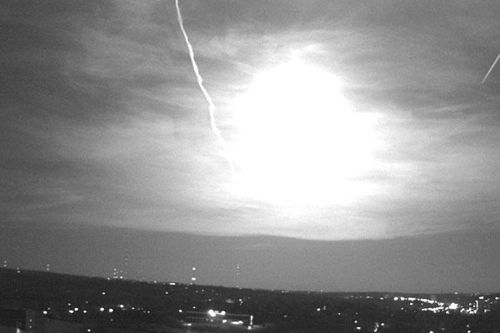
California Meteor Found Packed With Alien Organics
The Daily Galaxy
A sonic boom heard in California last week had an out-of-this world origin as ”a large meteoric event” according to NASA’s Meteoroid Environment Office. Scientists now estimate the blast measured in near 5 kilotons or roughly 1/3 the power of the atomic bomb dropped on Hiroshima, Japan during World War II.Bill Cooke of the Meteoroid Environment Office at NASA’s Marshall Space Flight Center, estimates the object was about the size of a minivan, weighed in at around 154,300 pounds.
"Most meteors you see in the night’s sky are the size of tiny stones or even grains of sand and their trail lasts all of a second or two," said Don Yeomans of NASA’s Near-Earth Object Program Office at the Jet Propulsion Laboratory in Pasadena, Calif. “Fireballs you can see relatively easily in the daytime and are many times that size – anywhere from a baseball-sized object to something as big as a minivan.”
The meteor appears to be much more valuable than scientists first thought. Meteorite hunters found fragments of the rock, identified by the "fusion crust" that forms when it burns in the atmosphere. NASA and the SETI Institute in Mountain View, California, also mobilised a search team of about 30 scientists to search for the small black rocks.
The meteorite turned out to be a very rare type of rock called CM chondrite, which makes up less than 1 per cent of the meteorites that fall to Earth. According to Bill Cooke of NASA's Meteoroid Environment Office at the Marshall Space Flight Center in Huntsville, Alabama, it is not clear whether it is rare because it easily burns up in the atmosphere or there are just fewer of these rocks in space.
The Murchison meteorite, a large CM chondrite--one of the oldest types of rock in the universe-- that made landfall in Australia in 1969, is now one of the most studied rocks in the world. CM chondrites contain carbon and organic materials such as amino acids. Some believe this type of meteorite may have brought the first building blocks of life to Earth.
A collaboration between various US and European institutes has proven the presence of vital nucleobases in the Murchison meteorite, an extraterrestrial rock fragment which impacted Earth in 1969. Nucleobases are the very binary bits of DNA, the base pairs that make up the vital genetic information. Uracil and Xanthine were the two of the most exciting components detected. Uracil is Thymines stand-in when RNA is created, and Xanthene is a mutated form of Guanine.
These bases are unquestionably alien - for one, the rock-chemicals are equally left and right "handed" (a property of the physical structure of the chemicals), while the Earth-borne biological equivalents are either one or the other(sugars are right-handed, amino acids are left-handed). Even more fundamentally, the carbon atoms that make these chemicals organic at all are a space born isotope, the not-so-unlucky Carbon-13, while life on Earth is based on Carbon-12.
Strikes of such substances early in evolution may have played a vital role in the development of Earth biology - and with these precious particles literally falling out of the sky, the odds of life off-planet seem better than ever.
In 2010 Scientists have identified the microscopic remnants of a nearby star that exploded in a supernova immediately before or during the birth of the solar system 4.5 billion years ago. Faint traces of the supernova, found in a meteorite, account for the mysterious variations in the chemical fingerprint of chromium found from one planet and meteorite to another, according to findings by University of Chicago cosmochemist Nicolas Dauphas and team.
Scientists have known for four decades that a supernova probably occurred approximately 4.5 billion years ago, possibly triggering the birth of the sun. Their evidence: traces of aluminum 26 and iron 60, two short-lived isotopes found in meteorites but not on Earth.
These isotopes could have come from a type II supernova, caused by the core-collapse of a massive star. “It seems likely that at least one massive star contributed material to the solar system or what was going to become the solar system shortly before its birth,” Meyer said.
ThesScientists formerly believed that chromium 54 and other elements and their isotopic variations became evenly spread throughout the cloud of gas and dust that collapsed to form the solar system.
“It was a very well-mixed soup,” said Bradley Meyer, a professor of astronomy and astrophysics at Clemson University. “But it looks like some of the ingredients got in there and didn’t get completely homogenized, and that’s a pretty interesting result.”
Researchers have already extracted many type II supernova grains from meteorites, but never from a type IA supernova. The latter type involves the explosion of a small but extremely dense white-dwarf star in a binary system, one in which two stars orbit each other. It should now be possible to determine which type of supernova contributed the chromium 54 to the Orgueil meteorite.
“The test will be to measure calcium 48,” Dauphas said. “You can make it in very large quantities in type Ia, but it’s very difficult to produce in type II.” So if the grains are highly enriched in calcium 48, they no doubt came from a type Ia supernova.
Cosmochemists have sought the carrier of chromium 54 for the last 20 years but only recently have instrumentation advances made it possible to find it. Dauphas’s own quest began in 2002, when he began the painstaking meteorite sample-preparation process for the analysis he was finally able to complete only last year.
Dauphas and his associates spent three weeks searching for chromium 54-enriched nanoparticles with an ion probe at the California Institute of Technology. “Time is very precious on those instruments and getting three weeks of instrument time is not that easy,” he said.
The researchers found a hint of an excess of the chromium-54 isotope in their first session, but as luck would have it, they had to search 1,500 microscopic grains of the Orgueil and Murchison meteorites before finding just one with definitely high levels.
The grain measured less than 100 nanometers in diameter — 1,000 times smaller than the diameter of a human hair. “This is smaller than all the other kinds of presolar grains that have been documented before, except for nanodiamonds that have been found here at the University of Chicago,” Dauphas said.
The findings suggest that a supernova sprayed a mass of finely grained particles into the cloud of gas and dust that gave birth to the solar system 4.5 billion years ago. Dynamical processes in the early solar system then sorted these grains by size. These size-sorting processes led the grains to become disproportionally incorporated into the meteorites and planets newly forming around the sun.
“It’s remarkable that you can look at an isotope like chromium 54 and potentially find out a whole lot about what happened in the very first period of the solar system’s formation,” Meyer said.
The black and white photo below is from a rooftop webcam released Thursday, April 15, 2010, by the University of Wisconsin-Madison Department of Atmospheric and Oceanic Sciences shows a fireball as it passed over Madison, Wis. Scientists say it's likely a similar meteor flew over parts of northern California and Nevada Sunday morning.
The Daily Galaxy via University of Chicago, upi.com and newscientist.com
Image credit: AP Photo/University of Wisconsin-Madison Department of Atmospheric and Oceanic Sciences


